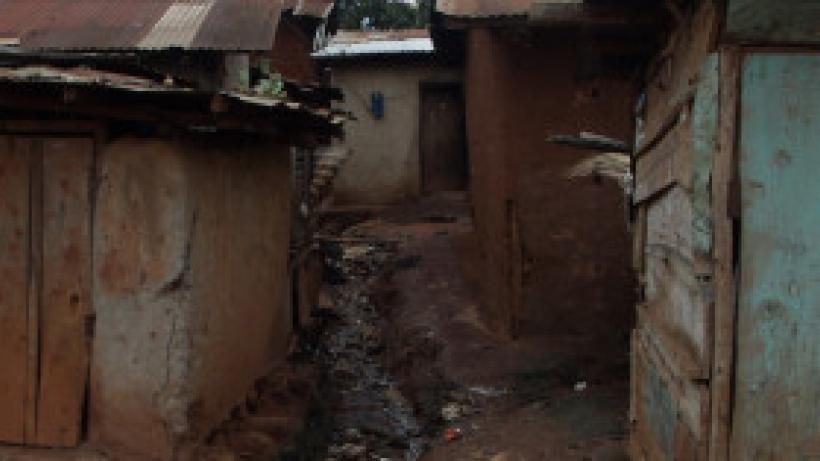
Delivering sanitation in Kampala
Already, only 10% of Kampala’s population have access to proper sewerage. With increasing urbanisation, delivering sanitation in Kampala will become even more challenging. How should policymakers address the future for sanitation in urban Uganda?
Only 10% of Kampala’s population have access to proper sewerage. With increasing urbanisation, delivering sanitation in Kampala will become even more challenging. How should policymakers address the future for sanitation in urban Uganda?
With trousers and sleeves rolled-up, every day there are Ugandans who jump into pit-latrines full of human excrement. With a bucket, and sometimes drunk, they proceed to empty the pit-latrine as a self-run business. What they are doing is certainly not glamorous, but they play an important role in dealing with Kampala’s growing sanitation challenge.
As Uganda grows and people move to cities, Kampala (which already holds two-thirds of Uganda’s urban population) is set to face enormous pressures. For sanitation, that pressure could become chronic. Currently, only around 10% of the city has formal sewerage connections, and some estimates reach as low as 7%. The majority of the city’s people, who mostly live in informal housing, make do with pit-latrines or inadequate sanitation facilities that do not handle human waste responsibly. This is alarming given Kampala’s position amidst wetlands and next to the world’s second-largest freshwater lake. Sanitation in Kampala is something which needs to be got right.
The challenge is to create a market for sanitation products and services which solves the problems of poor sanitation, and promotes the benefits of good sanitation. However, sanitation has collective benefits and costs which cannot entirely be confronted privately, getting sanitation right is not just about removing market obstacles but also carries a public dimension.
This raises questions about subsidies and public provision, though these are complicated in myriad ways, from their design, financing, and implementation. Simply supplying sanitation facilities is not always enough to ensure usage. Even when there is demand, it’s not always met. Demand for sanitation, though often large, may also not be sufficient for willingness-to-pay. There is a lot more we need to understand about sanitation generally.
In addition to the general challenges, in Kampala there are local dynamics. To learn more, we spoke to Sanitation Solutions Group, which runs a latrine construction business with a privately-contracted pit-latrine emptying service. Demand in Kampala for latrines appears large, but willingness-to-pay is low. Solving this could be important for generating a sustainable market, but why exactly people don’t pay and how to get them to pay is not clear. It could be explained by the public nature of sanitation. It might also be that households aren’t aware of the precise benefits. This is curious since improved sanitation appears to have large impacts on educational attainment, and we’ve observed in other research that households in poverty will actually endure starvation when school fees are due. Perhaps providing information on school attainment might solve this.
On the other hand, it might be the size of the investment or heavily discounting future values – but households’ commitments to school fees make this puzzling. Notably, the broader impacts in health and education seem much higher for females than males. There may be biological factors, but there may also be intra-household dynamics: perhaps girls get a disproportionate share of household duties and are under-nourished, making them more susceptible to disease, reducing their attendance and performance in school? Maybe it comes down to who controls the budget: women are more likely to pay, but men usually hold the money. It is worth noting too, that better sanitation reduces female assault, since women are more likely to have to travel in the dark through slums to communal facilities.
This might change how we should think about possible subsidies, favouring transfers to female household heads instead of other options. It might also change how we think about other challenges in Kampala. Similar to increasing access to energy, better sanitation may be an important part of improving education in the region, which lags behind regional peers.
Another dimension in harnessing demand and payment may reside in the externalities of improved sanitation, which accrue to households. Areas with better sanitation usually have higher income. Of course, wealthier areas are more able to afford better sanitation, but there is anecdotal evidence that providing better sanitation does actually raise incomes, through greater productivity and less work days lost to illness, and also through higher rental incomes. It wouldn’t be straightforward, but are there possibly ways that part of this benefit accruing to individuals and households could be used to support better sanitation?
There is a lot more to sanitation in Kampala than covered here. It is definitely a complex area worthy of research, and a very important one too. The importance is not lost on the Kampala Capital City Authority (KCCA) who are eager to address this challenge, especially as expanding formal sewerage is a very costly and possibly unrealistic objective in the near term. Just as chlorine tablets in Kenya turned out to be effective and far cheaper than expanding piped water access, there are other policy options to consider. KCCA has expressed explicit interest in further understanding sanitation in Kampala, especially as they are seeking to develop a sanitation strategy.
Unquestionably, Kampala’s sanitation is an area ideal for analysis and research.

